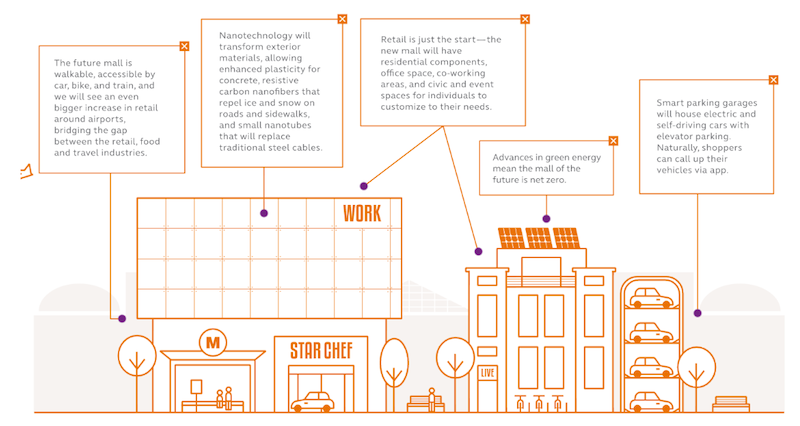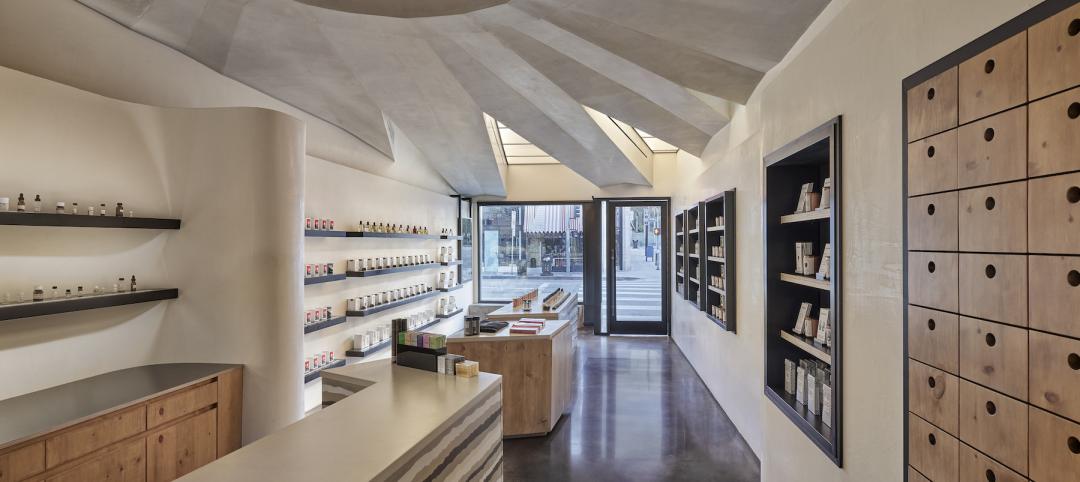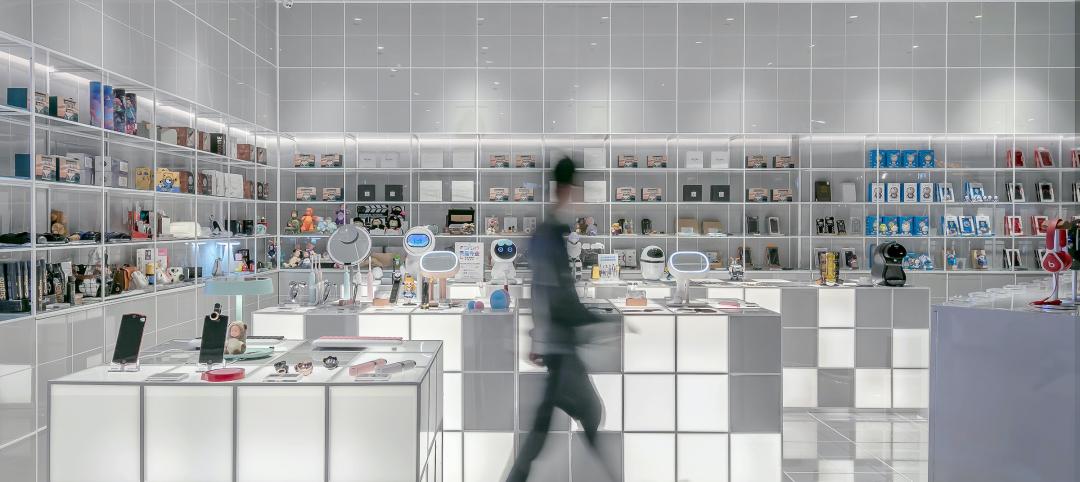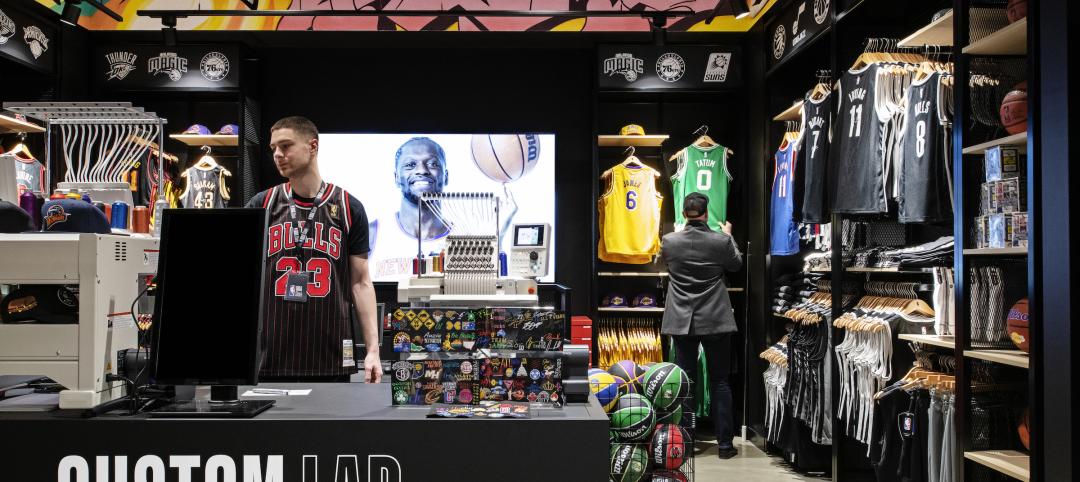The shopping mall of tomorrow will be more like a community center, with access to mass transit, offices, apartments, museums, and services like childcare. Already, some malls have become micro cities that are “changing the face of American retail,” according to CallisonRTKL in its “Mall of the Future,” a compendium of ideas and design trends that the firm believes could drive where shopping malls and retail will be heading over the next two decades.
The firm’s portfolio includes some of the world’s largest and most complex retail malls, so it’s not surprising that CallisonRTKL foresees shopping centers as focal points of urbanized living. Indeed, the firm all but predicts that malls that don’t move in this direction are in danger of becoming extinct at a time when at least one-third of the 1,200 retail malls in the U.S. are on death’s doorstep, and customer expectations about their shopping experiences are rapidly evolving.
'Design wise, malls will require twice the common area of typical malls we see today.'
For one thing, customers want to get out of their cars. CallisonRTKL’s report cites research from the Urban Land Institute, which finds a strong preference among all adult age groups to live in or near mixed-use, walkable neighborhoods.
More broadly, the new generation of shopper is seeking new experiences, not just waiting for them. Retail centers must be flexible in their spaces and assortments to continually offer enough variety that can drive customer traffic. Citing research from Medallia Analysis, CallisonRTKL points out that satisfied customers spend, on average, 140% more than people who are less satisfied with their shopping experiences.
Despite double-digit growth in online shopping in recent years, CallisonRTKL remains bullish on bricks-and-mortar shopping centers.
One of their major competitive responses to online shopping’s encroachment has been food: CallisonRTKL notes that for the first time ever, Americans in 2015 spent more money on dining out than on buying groceries. So malls are adding higher-end restaurants that feature local cuisine. More retail centers are giving customers the option of ordering food online and picking it up at the mall. Some centers have even programmed space for farmers’ markets and community gardens.
Technology is transforming the mall environment. It is unleashing areas used for warehouse space for “click and collect” products and same-day delivery of online sales. More malls are installing interactive maps and wayfinding signage. The Internet of Things is helping retailers market directly and instantaneously to wired shoppers via their smartphones.
 Shopping will just be one facet of tomorrow's successful malls, which will tap into customers' desire to live in walkable, greener communities. Image: CallisonRTKL's “Mall of the Future” report
Shopping will just be one facet of tomorrow's successful malls, which will tap into customers' desire to live in walkable, greener communities. Image: CallisonRTKL's “Mall of the Future” report
CallisonRTKL expects all of these trends to become more widely applied in the malls of tomorrow. The firm foresees walkable malls accessible by public transit or bicycles. Malls will include residential, office, civic, and event spaces. They will be powered by renewable energy. Smart parking garages will accommodate electric cards, and driver apps. The firm also expects more malls to be built near airports, “bridging the gap between retail, food, and travel industries.”
Technology will seep into every aspect of a mall’s design, construction, and operations. “It’s not about gadgets; it’s about infrastructure,” CallisonRTKL wrote. Nanotechnology will help develop better, more durable building products with smaller carbon footprints. Click and collect “will remain and must,” and be much quicker. Broader and better connectivity will provide a customized shopping experience. Stores will include interactive fitting suites that allow customers to digitally try on products before ordering them online. Stores will stock less, and use extra space for warehousing inventory for same-day drone delivery.
Rooftops of malls will be employed for entertainment, dining, and gardens, and be “greener” by reducing heat transmission and water runoff. Customers will use apps to have food and goods delivered anywhere, with alerts for when the pickup is ready and where. Robot delivery will be an option for some malls.
Food will anchor the retail experience, in the forms of restaurants, farms, pop-up vendors, specialty stores, and food festivals. Some of these could be programmed to change daily.
CallisonRTKL goes so far as to suggest that some malls might allow diners the option of growing their own dinners from onsite vegetable gardens and urban beehives. At the very least, successful malls will have pop-up infrastructures that are anchored by preset retail common areas. “Design wise, malls will require twice the common area of typical malls we see today.”
CallisonRTKL foresees more consumers actively seeking shopping experiences that align with their environmentalist inclinations. Streamlined sourcing labels, more dependable vetting processes, and increased connectivity will make it easier for shoppers to choose retailers and products that have a positive effect. “This is a consumer-driven movement that is only going to grow stronger in the next few years.”
Related Stories
Engineers | Nov 27, 2023
Kimley-Horn eliminates the guesswork of electric vehicle charger site selection
Private businesses and governments can now choose their new electric vehicle (EV) charger locations with data-driven precision. Kimley-Horn, the national engineering, planning, and design consulting firm, today launched TREDLite EV, a cloud-based tool that helps organizations develop and optimize their EV charger deployment strategies based on the organization’s unique priorities.
Retail Centers | Nov 15, 2023
Should retail developers avoid high crime areas?
For retailers resolute to operating in high crime areas, design elements exist to mitigate losses and potentially deter criminal behavior.
Retail Centers | Nov 7, 2023
Omnichannel experiences, mixed-use development among top retail design trends for 2023-2024
Retailer survival continues to hinge on retail design trends like blending online and in-person shopping and mixing retail with other building types, such as offices and residential.
Sponsored | | Oct 24, 2023
Dark Deliveries in Retail Stores
Wireless Access Control Allows for Safe Deliveries During Retail Off-Hours
Adaptive Reuse | Sep 19, 2023
Transforming shopping malls into 21st century neighborhoods
As we reimagine the antiquated shopping mall, Marc Asnis, AICP, Associate, Perkins&Will, details four first steps to consider.
Retail Centers | Sep 13, 2023
Stars are aligned for growth in luxury retail sector
JLL's Luxury report says pent-up demand and lack of available selling space are driving this market.
Adaptive Reuse | Sep 13, 2023
Houston's first innovation district is established using adaptive reuse
Gensler's Vince Flickinger shares the firm's adaptive reuse of a Houston, Texas, department store-turned innovation hub.
Giants 400 | Sep 12, 2023
Top 75 Retail Sector Engineering and Engineering Architecture (EA) Firms for 2023
Kimley-Horn, Henderson Engineers, Jacobs, and EXP head BD+C's ranking of the nation's largest retail building engineering and engineering/architecture (EA) firms for 2023, as reported in the 2023 Giants 400 Report. Note: This ranking factors revenue for all retail buildings work, including big box stores, cineplexes, entertainment centers, malls, restaurants, strip centers, and theme parks.
Giants 400 | Sep 12, 2023
Top 80 Retail Sector Contractors and Construction Management Firms for 2023
Whiting-Turner, ARCO Construction, Swinerton, and PCL top BD+C's ranking of the nation's largest retail building contractors and construction management (CM) firms for 2023, as reported in the 2023 Giants 400 Report. Note: This ranking factors revenue for all retail buildings work, including big box stores, cineplexes, entertainment centers, malls, restaurants, strip centers, and theme parks.
Giants 400 | Sep 11, 2023
Top 140 Retail Sector Architecture and Architecture Engineering (AE) Firms for 2023
Gensler, Arcadis, Core States Group, WD Partners, and NORR top BD+C's ranking of the nation's largest retail sector architecture and architecture engineering (AE) firms for 2023, as reported in the 2023 Giants 400 Report. Note: This ranking factors revenue for all retail buildings work, including big box stores, cineplexes, entertainment centers, malls, restaurants, strip centers, and theme parks.

















